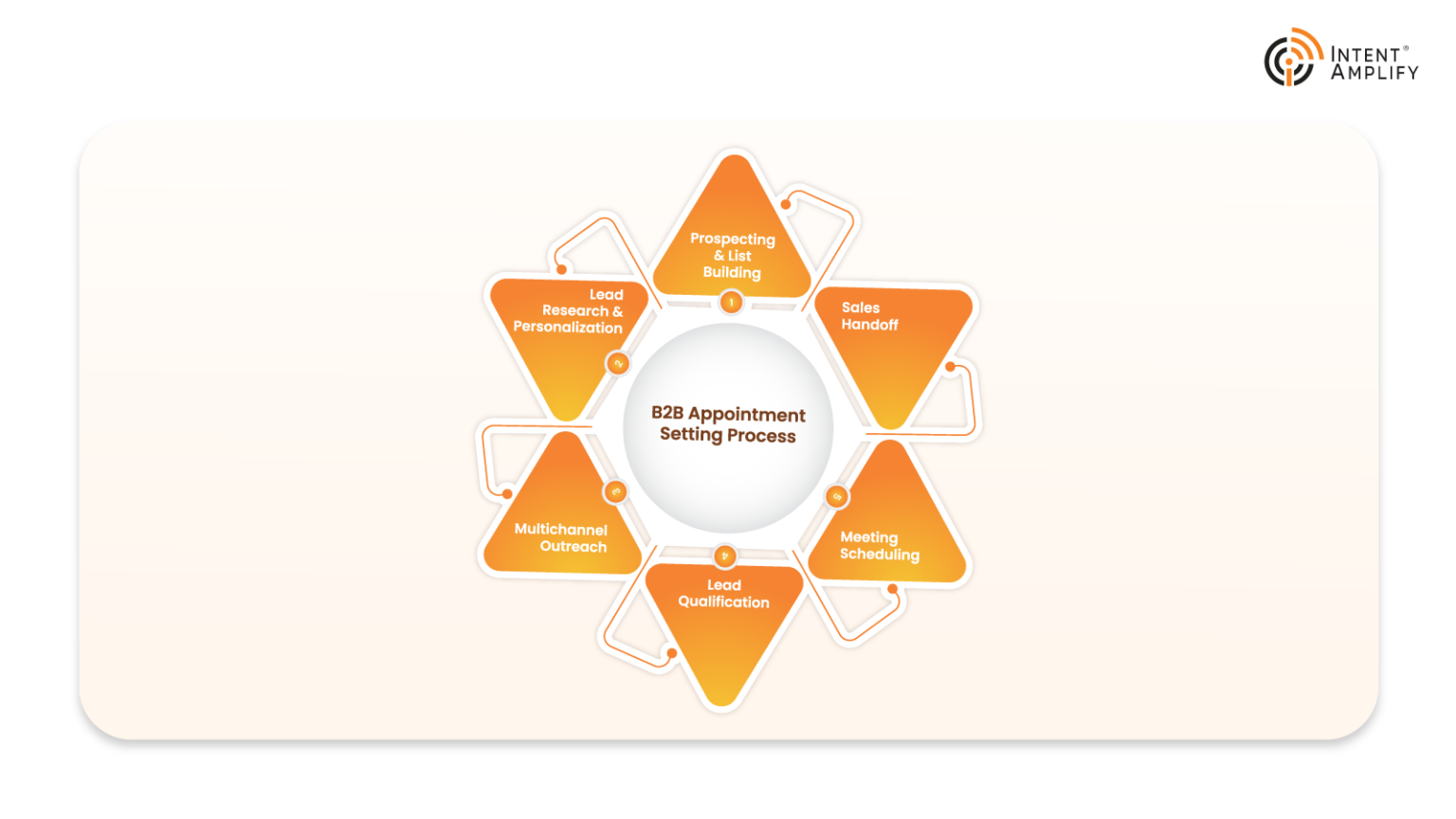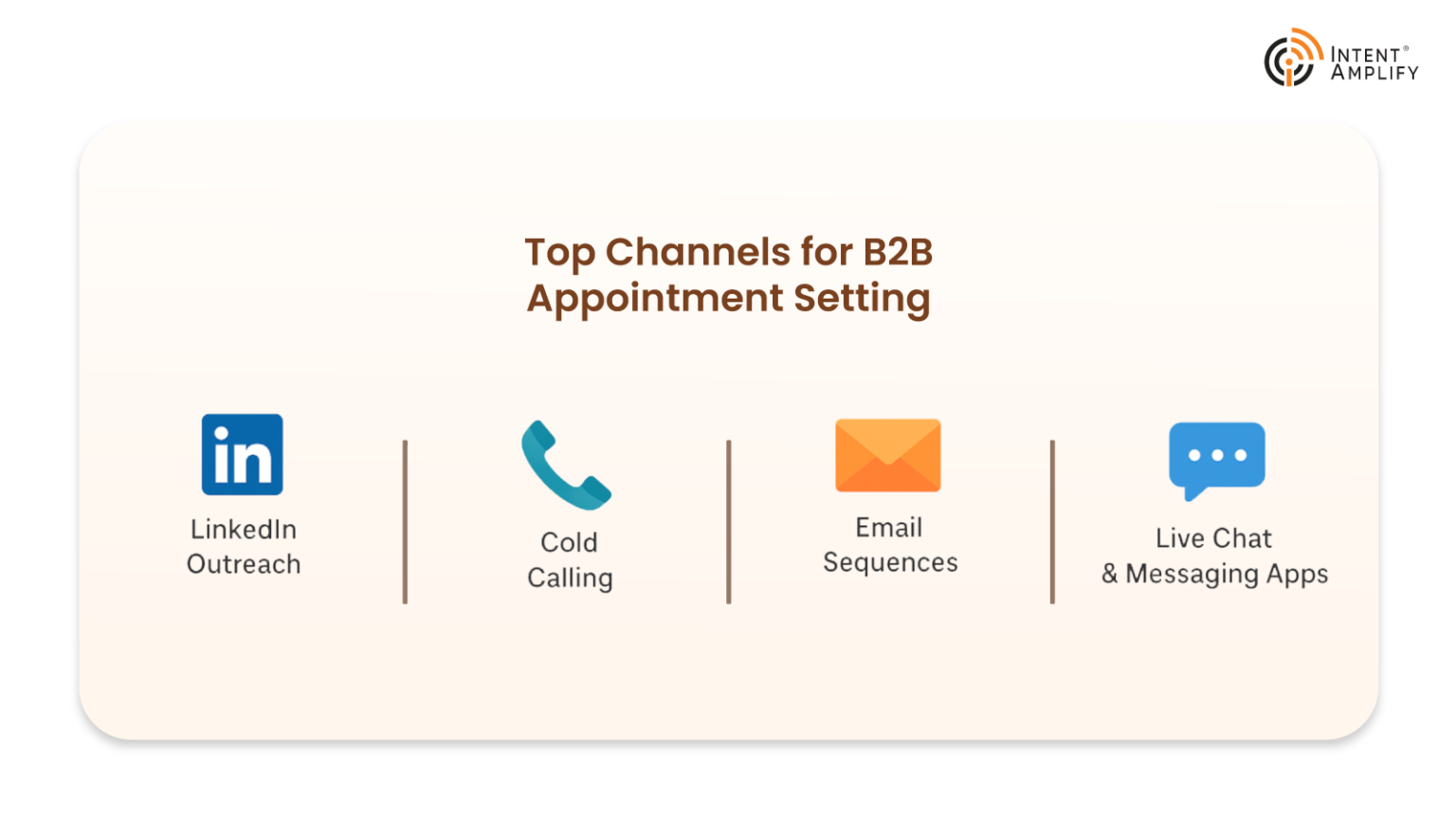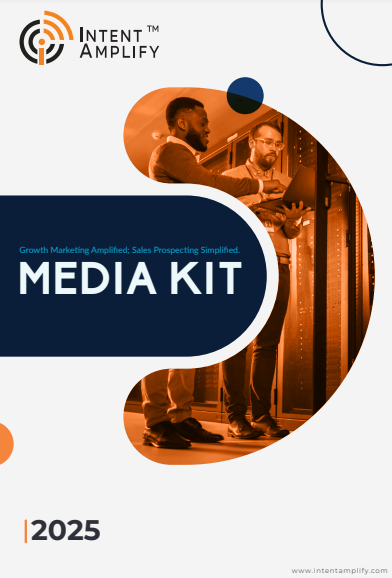
What Is B2B Appointment Setting? Strategies, Tools & Trends for 2025
- Last updated on: July 14, 2025
As a B2B marketer, you’ve probably seen it firsthand – getting traffic is one thing, but turning that interest into a real sales conversation? That’s where most teams get stuck. In 2025, appointment setting has moved from being a sales support task to a core revenue strategy. Buyers are more selective, inboxes are more crowded, and one-size-fits-all outreach no longer works.
That is why appointment setting is more crucial than ever. It gives your salespeople a direct line to decision-makers who are willing to talk. It saves time, reduces noise, and keeps your funnel full of warm, qualified meetings. Here, we’ll walk you through what appointment setting is, how it happens, and why it is now something businesses that must grow with purpose and precision require.
What Is Appointment Setting in B2B?
B2B appointment setting is the process of qualifying leads, contacting them, and scheduling sales meetings between prospects and your salespeople. It’s not about filling calendars with cold calls; it’s about creating real sales opportunities with decision-makers that fit your ideal customer profile.
It’s like the middle ground between marketing and closing. Whereas lead gen brings them through the funnel, appointment setting qualifies them and advances them. In B2B, where you’re often dealing with multiple stakeholders and complex buying decisions, that middle step is essential. Whether you do it in-house or team up with a specialist partner, your goal is the same: to book meetings that matter. When done right, appointment setting is a surefire way to build relationships, increase win rates, and shorten your sales cycle.
How Intent Amplify Defines Appointment Setting?
At Intent Amplify, appointment setting is more than just booking meetings – it’s a strategic, high-touch process that bridges marketing and sales. We view it as the art and science of turning cold outreach into qualified conversations. By leveraging data, behavioral insights, and personalized outreach, we help B2B companies cut through the noise and connect with the right decision-makers at the right time. Our appointment-setting approach ensures that every meeting is backed by context, qualification, and real buyer intent, so sales teams can close faster with confidence.
Whether it’s through outbound prospecting or nurturing inbound leads, we focus on precision, timing, and messaging that resonates. That’s how we drive predictable pipeline growth for B2B businesses looking to scale in competitive markets. This definition anchors everything we do in our service offering, which you can explore here.
Who Handles Appointment Setting?
Appointment setting for B2B companies is usually done by Sales Development Representatives (SDRs) or Business Development Representatives (BDRs). They are your front-line experts who filter leads, tailor contacts, and determine if a prospect meets your requirements before sending them over to an Account Executive (AE).
But it’s not just humans – it’s also the tools that facilitate them. SDRs today are reliant on platforms like Outreach, Apollo, or Salesloft to manage follow-ups, automate sequences, and track conversations. And as your business expands, you might think about hiring an agency that is appointment-setting centered.
Outsourcing is especially useful when you’re entering new markets or need immediate results. Agencies offer tested structures, experienced teams, and broad market knowledge. Whatever the in-house or outsourced method, consistency and alignment with your sales goals are the top priority.
Types of Appointment Setting
In 2025, B2B companies rely on two main types of appointment setting: inbound and outbound. Let’s break them down.
- Inbound appointment setting focuses on leads who’ve already expressed interest. These leads come from form submissions, demo requests, content downloads, or webinar attendance. They’re warmer, but you still need to qualify them—interest doesn’t always mean intent.
- Outbound appointment setting, on the other hand, involves reaching out to prospects who haven’t engaged yet. It requires a proactive approach—cold emails, LinkedIn outreach, and direct calls. This method demands sharp targeting, compelling messaging, and a solid understanding of your ideal customer profile.
The best B2B teams don’t choose between inbound and outbound; they combine both. This full-funnel approach ensures that you’re consistently generating qualified meetings from every angle.
Why Appointment Setting Is Important for B2B Success?
You might think your marketing team already brings in enough leads, but are they converting? That’s where appointment setting becomes essential. It transforms top-of-funnel activity into bottom-line results. Here’s how it drives impact:
- Pipeline Acceleration: Qualified meetings move deals faster through the funnel.
- Higher Sales Efficiency: Reps focus on selling, not chasing unqualified leads.
- Stronger Sales-Marketing Alignment: Appointment setters bridge the gap between MQLs and sales-ready leads.
- Improved ROI: Every marketing dollar works harder when follow-up is intentional.
- Better Conversion Rates: Pre-qualified leads are more likely to convert to closed deals.
- More Predictable Revenue: With a steady stream of appointments, forecasting becomes easier.
- Increased Buyer Engagement: Personalized outreach encourages real-time, meaningful interaction.
- Higher Win Rates: Well-qualified meetings lead to better close ratios.
- Reduced Sales Cycle Time: Engaging the right person at the right time shortens the decision journey.
- Enhanced Sales Focus: Your sales team can concentrate on what they do best – closing.
Appointment setting ensures your team isn’t spinning its wheels. It’s the engine behind predictable growth. With a well-structured process and consistent execution, your team can spend more time closing deals and less time chasing cold leads.
The B2B Appointment Setting Process
The process of appointment setting in B2B is not just a series of calls or emails – it’s a strategic sequence that moves leads closer to revenue. Here’s how successful teams manage it, step by step:
- Prospecting and List Building: Start by identifying high-fit accounts using firmographics and intent data. Tools like ZoomInfo, Clearbit, and LinkedIn Sales Navigator help build smart lists.
- Lead Research and Personalization: Go beyond names and titles. Learn about each company’s pain points, industry trends, and individual decision-maker roles. This helps tailor your messaging for impact.
- Multichannel Outreach: Use a coordinated strategy involving email, phone, and LinkedIn to maximize your chances of reaching the prospect. Sequencing matters—spread out touches over a few days.
- Lead Qualification: Before booking a call, ask the right questions. Use frameworks like BANT or CHAMP to confirm budget, authority, and timing.
- Scheduling the Meeting: Use booking tools like Calendly or Chili Piper to make it easy. Send reminders and confirmations to reduce no-shows.
- Sales Handoff: Provide your sales team with notes, call history, and insights gathered. This ensures continuity and makes the first sales call more productive.
This process, when tracked and optimized regularly, builds consistency and scale. Appointment setting isn’t a one-off tactic – it’s a repeatable system for revenue.
Top Channels Used in 2025 for Appointment Setting
In 2025, appointment setting isn’t just about cold calls – it’s about smart, synchronized outreach across platforms your prospects use. Here are the channels that top B2B teams rely on:
- Cold Email: Still one of the most effective tools when done right. Personalized subject lines, relevance, and value-driven messaging can break through crowded inboxes. Combine with automation for scale without losing the human touch.
- LinkedIn Messaging: Social selling is no longer optional. LinkedIn offers direct access to decision-makers and lets you build familiarity before making a pitch. Custom connection requests and follow-ups drive high engagement.
- Phone Calls: Old school, but still powerful. Especially effective for re-engaging warm leads or following up on digital touches. Many execs still appreciate a human voice.
- Retargeting and Paid Ads: Use platforms like LinkedIn Ads and Google Display to warm up leads before outreach. They build brand awareness and help cold leads recognize your name.
- AI Chatbots and Instant Booking Widgets: These tools allow you to capture inbound interest the moment it happens – no forms or back-and-forth emails needed.
Effective appointment setting in 2025 means orchestrating these channels to work in tandem. Omnichannel outreach isn’t just a buzzword – it’s a necessity for results.
Key Challenges in Appointment Setting (and Solutions)
Appointment setting has its challenges. But each hurdle has a fix. Here’s how to overcome the most common roadblocks that teams face today:
- Low Response Rates: Generic messaging won’t cut it anymore. To improve response, tailor your outreach to the recipient’s industry, role, and recent activity. Use dynamic fields, personalized subject lines, and compelling openers to increase engagement. A/B test your emails to find what works.
- Reaching Decision-Makers: Gatekeepers are real, and inboxes are crowded. Account-based strategies can help you pinpoint key stakeholders across an organization. Combine email with LinkedIn messages, retargeting ads, and warm introductions to increase touchpoints.
- Scheduling Conflicts: Eliminate back-and-forth by offering pre-set slots through tools like Calendly or Chili Piper. Give options based on time zones and working hours. Include calendar links in every message and follow up with reminders.
- Bad Data and Lead Quality: Outdated or irrelevant data can derail campaigns. Regularly clean your CRM and use enrichment tools like Clearbit or Apollo. Focus on verified contacts and accounts that match your ICP.
- No-Shows and Drop-offs: Confirmation emails, SMS reminders, and pre-meeting agendas improve show-up rates. Reinforce the meeting’s value in every interaction.
By tackling these issues head-on, you improve not just the quantity of meetings but also the quality and close rate of your pipeline.
Best Practices for Booking More Qualified Meetings
Want to increase your meeting conversion rate? Use these battle-tested practices to drive real results:
- Target Based on Buyer Intent: Use tools like Bombora or ZoomInfo to identify accounts already showing interest in your solution. Focus your outreach on these high-intent leads to improve conversions.
- Refine Your Ideal Customer Profile (ICP): Stop casting a wide net. A precise ICP helps your team prioritize the right companies based on size, industry, pain points, and buyer readiness.
- Automate Without Losing the Human Touch: Use email and LinkedIn automation tools to save time but make each message feel personal. Include their name, company news, or specific challenges they’re facing.
- Coach Your Team Continuously: Don’t rely on old scripts. Train your SDRs and BDRs regularly in objection handling, new outreach formats, and tone matching. Role-play sessions and performance reviews can help sharpen delivery.
- A/B Test Everything: From subject lines to CTAs and even meeting times, test and iterate. Use analytics to double down on what works and cut what doesn’t.
Appointment setting is not guesswork—it’s a skill that improves with focus, feedback, and data. Make refinement part of your culture and watch your meetings get better and more frequent.
Should You Outsource Appointment Setting?
Not every business has the time or team to do appointment setting in-house. That’s where outsourcing can be a smart move. You should consider outsourcing if:
- Your internal team is overloaded
- You’re entering new verticals or regions
- You need results faster than you can hire
- You want experienced reps from day one
Outsourced appointment setting gives you access to specialized talent, optimized workflows, and faster execution. But it only works if your partner deeply understands your industry and buyer.
Appointment Setting Tools & Tech Stack
In 2025, technology will play a central role in making appointment setting more efficient and effective. It’s no longer about managing spreadsheets or juggling tasks manually. Today’s appointment setters depend on a powerful tech stack that automates processes, tracks engagement, and personalizes outreach at scale.
Here are the key tools used in modern B2B appointment setting:
- CRM Platforms: Tools like HubSpot, Salesforce, or Pipedrive serve as the system of record. They help manage contacts, track conversations, and measure outcomes.
- Sales Engagement Platforms: Outreach, Apollo.io, and Salesloft allow reps to automate and personalize multichannel sequences.
- Lead Intelligence: ZoomInfo, Lusha, and Clearbit provide firmographic and contact data to fuel smart targeting.
- Meeting Scheduling: Calendly and Chili Piper make scheduling seamless and reduce friction for prospects.
- Intent Data Tools: Platforms like Bombora and Demandbase help identify prospects actively researching relevant topics.
These tools aren’t just about convenience, they’re about scalability. With the right tech stack, your team can reach more people, stay organized, and convert leads faster without compromising quality.
Trends Shaping the Future of Appointment Setting
The world of B2B appointment setting is evolving rapidly in response to shifting buyer behavior and new technologies. Understanding these trends can help your team stay ahead and remain competitive in 2025 and beyond.
- AI-Powered Outreach: Artificial intelligence now helps personalize messaging at scale, recommend optimal send times, and analyze responses to improve future performance. AI is making outreach smarter, not just faster.
- Buyer Intent Data: Instead of waiting for leads to raise their hands, teams are now using third-party intent signals to proactively reach out when buyers start researching topics online.
- Multi-Touch Campaigns: It’s no longer about just one cold call or email. High-performing teams use orchestrated sequences across email, LinkedIn, and phone to build rapport and stay top-of-mind.
- Remote-First Interactions: With remote work here to stay, virtual meetings have become the default. Tools like Zoom, Microsoft Teams, and Google Meet are now fully integrated into sales workflows.
- Trust-Driven Messaging: Inboxes are noisy. Appointment setters now prioritize relevance, trust, and personalization to stand out and build credibility.
These trends are reshaping what effective appointment setting looks like. Staying informed and agile will help you keep your pipeline full in a fast-changing market.
Strategic Booking Builds Better Pipelines
Appointment setting is a must-have for B2B growth. It connects your marketing efforts to sales results and ensures your team speaks to the right people at the right time. Done well, it becomes your most reliable growth engine. If you’re ready to take the guesswork out of booking meetings, let Intent Amplify help you build a consistent, high-quality pipeline that drives results.
FAQs
1. What exactly is appointment setting?
It’s the process of contacting and qualifying leads, then scheduling sales meetings with them. It bridges lead generation and closing.
2. How is appointment setting different from lead generation?
Lead generation gathers potential contacts. Appointment setting qualifies and converts them into sales meetings.
3. Should I outsource appointment setting?
Yes, especially if you lack time, expertise, or SDR resources. It helps scale outreach faster and with better precision.
4. What tools help with appointment setting?
CRMs like Salesforce, email platforms like Lemlist, LinkedIn tools, and scheduling apps like Calendly.
5. What’s a good conversion rate for appointment setting?
It varies, but 10–20% from cold outreach is considered healthy. With intent data and personalization, it can go higher.






